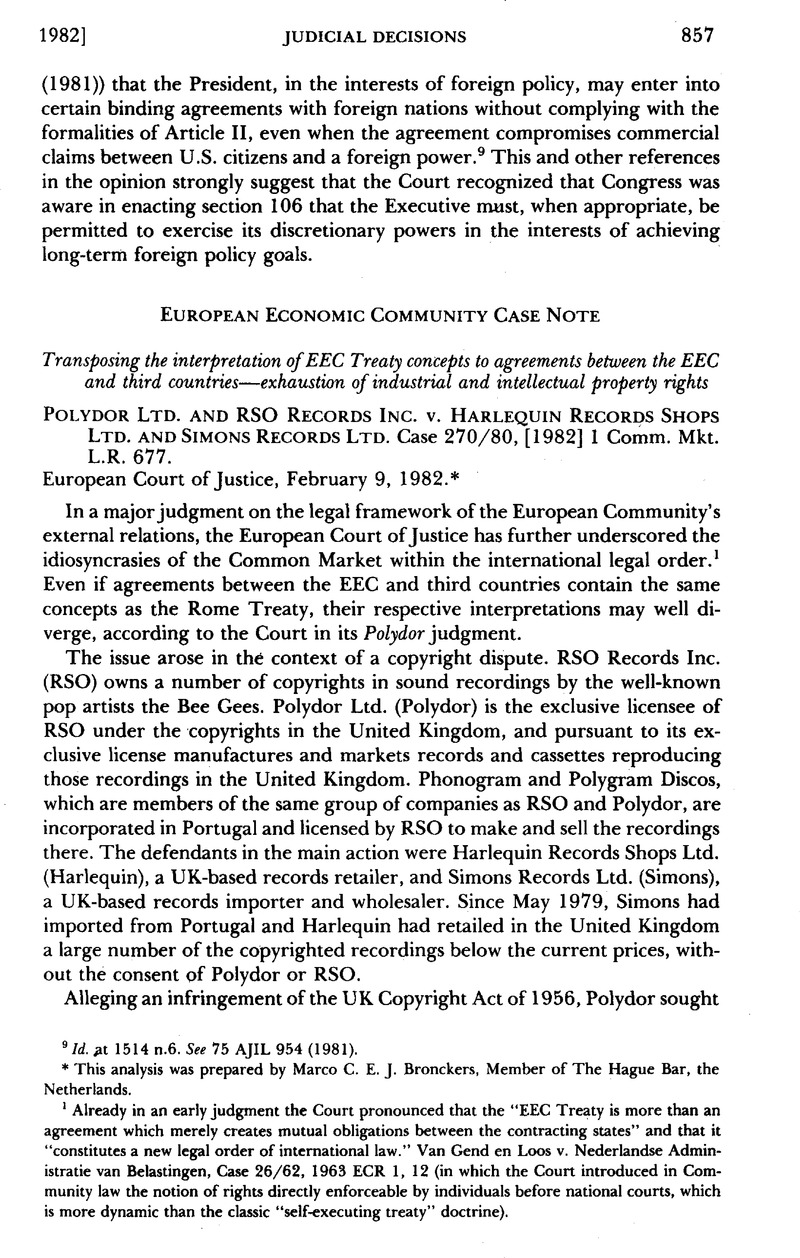Published online by Cambridge University Press: 27 February 2017

1 Already in an early judgment the Court pronounced that the “EEC Treaty is more than an agreement which merely creates mutual obligations between the contracting states” and that it “constitutes a new legal order of international law.” Van Gend en Loos v. Nederlandse Administrate van Belastingen, Case 26/62, 1963 ECR 1, 12 (in which the Court introduced in Community law the notion of rights directly enforceable by individuals before national courts, which is more dynamic than the classic “self-executing treaty” doctrine).
2 For the order of the Court of Appeal of May 15,1980, requesting a preliminary ruling from the European Court of Justice, see [1980] 2 Comm. Mkt. L.R. 413. For the interlocutory judgment of the Chancery Division of Dec. 21, 1979, which, incidentally, declined to refer the matter to the European Court ofjustice, see 1 id. at 669. For an instructive analysis of the procedural law of the European Communities, see H. G. Schermers, Judicial Protection in the European Communities (2d ed. 1979).
3 1972 O.J. Eur. Comm. (No. L 301) 166.
4 The remaining EFTA members and the bilateral free trade agreements with the EEC are: Austria, 1972 J.O. Comm. Eur. (No. L 300) 2; Finland, 1973 O.J. Eur. Comm. (No. L 328) 2; Iceland, 1972 J.O. Comm. Eur. (No. L 301) 2; Norway, 1973 O.J. Eur. Comm. (No. L 171) 2; Sweden, 1972 J.O. Comm. Eur. (No. L 300) 97; and Switzerland, id. at 189.
5 The Court’s balancing act under Articles 30 and 36 of the EEC Treaty was clearly reflected for the first time in the Deutsche Grammophon v. Metro judgment, Case 78/70, 1971 ECR 487. A recent study on the subject is D. Guy & G. Leigh, The EEC and Intellectual Property (1981).
6 Considerations 14 and 15 of the Membran v. GEM A judgment, Joined Cases 55 and 57/80, 1981 ECR 147.
7 This would hold true even if Polydor itself had not “consented” to the manufacture and distribution of the records by another affiliate of RSO; the European Court of Justice imputes consent to all members of a corporate group. See the Court’s judgment in Centrafarm v. Winthrop, Case 16/74, 1974 ECR 1183 (decision on trademarks).
8 In 1976 the Court had allowed EMI (Europe) to resist the importation from the United States into various EEC member states of “Columbia” records, a trademark originally registered worldwide by-CBS, but after a series of intricate agreements held by EMI within the EEC and by CBS in the United States. EMI v. CBS, Cases 51, 86, and 96/75, 1976 ECR 811, 871, and 913. CBS submitted that the import of its records into the Community could benefit from the “exhaustion” doctrine, apparently banking on an earlier judgment in a peculiar situation caused by nationalizations following World War II, where the Court had decided that independent holders of a trademark with a common origin could not prevent the parallel import of each other’s products marketed under the common trademark. Van Zuylen Freres v. Hag, Case 192/73, 1974 ECR 731. The Court, however, rejected out of hand the extension of its case law to imports from outside the Community as proposed by CBS. It should be noted that at that time there existed no bilateral free trade agreement, such as the Agreement in issue in the Polydor case, between the Community and the United States, nor does one exist today. See also the 2d Bouhelier judgment, Case 225/ 78, 1979 ECR 3151 (the interpretation of Treaty provisions bringing about the complete liberalization of intra-Community trade cannot as such be transposed to relations with nonmember countries).
9 Bresciani v. Amministrazione Italiana delle Finanze, Case 87/75, 1976 ECR 129.
10 The two Yaoundé Conventions were the forerunners of the Lomé Conventions between the European Community and some 60 A(frican)-C(aribbean)-P(acific) countries, the second of which entered into force on Jan. 1, 1981. 1980 O.J. Eur. Comm. (No. L 347) 1. For the Yaounde 1 Convention, see 1964 J.O. Comm. Eur. 1430.
11 See Dittrich, , Die Verträge österreichs mit den Europäïschen Gemeinschaften und das österreichisches Urheberrecht , 26 Österreichische Blätter für Gewerblichen Rechtsschutz und Ur heberrecht 81, 86 (1977)Google Scholar. Dittrich also observes that the “exhaustion” doctrine is not recognized under Article XX of the General Agreement on Tariffs and Trade (GATT), which he considers to have, been a model for Article 12 of the EFTA Convention, implicitly for the Agreement’s safeguards clause, and even for Article 36 of the EEC Treaty. Id. at 86-87. Both Portugal and the European Community are contracting parties to the GATT.
12 Austro-Mechana v. Gramola Winter & Co., judgment of the Austrian Supreme Court of July 10, 1979, reprinted in 29 Gewerblicher Rechtsschutz und Urheberrecht (Internationaler Teil) 185 (1980), with annotation by Eugen Ulmer (injunction against imports of copyrighted sound recordings lawfully marketed in West Germany granted to the copyright holder in Austria); Sunlight A.G. v. Bosshard Partners Intertrading, judgment of the Swiss Supreme Court of Jan. 25, 1979, reprinted in 28 id. at 569 (1979) (Swiss trademark owner may resist imports from the Netherlands and West Germany of products manufactured there under his license).
13 Pabst & Richarz v. Hauptzollamt d’Oldenbourg, Case 17/81 (Judgment of April 29, 1982, not yet published).
14 1963 J.O. Comm. Eur. 293. The Community has entered into Association Agreements with Cyprus, 1973 O.J. Eur. Comm. (No. L 133) 1; Malta, 1971 J.O. Comm. Eur. (No. L 61) 1; and Turkey, 1964 id. at 3687, as well. For a survey of all Community agreements in force or valid on Jan. 1, 1981, see App. 3 to A. Parry & S. Hardy, EEC Law 494-519 (2d ed. A. Parry & J. Dinnage 1981).